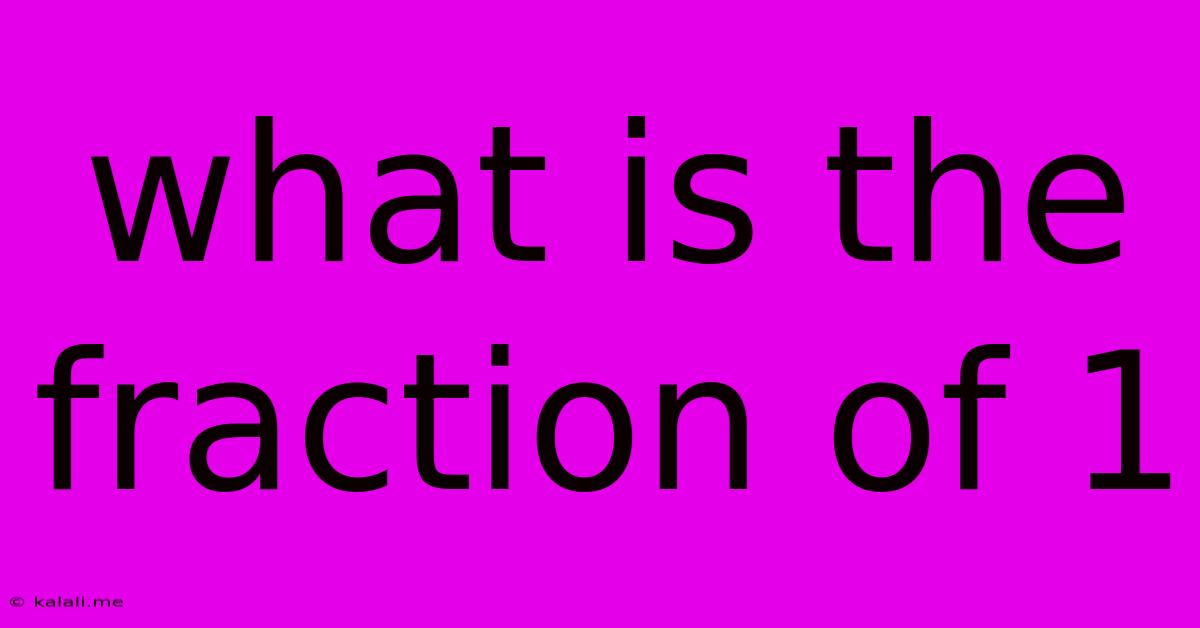What Is The Fraction Of 1
Kalali
May 09, 2025 · 2 min read

Table of Contents
What is the Fraction of 1? Understanding Whole Numbers as Fractions
The question "What is the fraction of 1?" might seem deceptively simple, but it touches upon a fundamental concept in mathematics: representing whole numbers as fractions. Understanding this is crucial for grasping more advanced mathematical concepts. This article will explore different ways to express 1 as a fraction and highlight its significance in various mathematical operations.
The Simple Truth: 1 as a Fraction
The simplest way to express 1 as a fraction is 1/1. This means one whole divided into one equal part. Any number divided by itself always equals 1. This is a foundational concept in arithmetic.
Beyond 1/1: Equivalent Fractions
While 1/1 is the most straightforward representation, 1 can be expressed as an infinite number of equivalent fractions. An equivalent fraction maintains the same value even though the numerator and denominator change. To create an equivalent fraction of 1, you simply use any number for both the numerator and denominator:
- 2/2: Two halves make a whole.
- 3/3: Three thirds make a whole.
- 4/4: Four quarters make a whole.
- 5/5, 6/6, 100/100, and so on. The pattern continues infinitely.
Why Understanding This Matters
The ability to represent 1 as various fractions is essential for several mathematical operations:
-
Adding and Subtracting Fractions: Finding a common denominator often involves converting fractions to equivalent fractions with the same denominator. Understanding that 1 can be represented as various fractions is key to this process. For instance, adding 1/2 + 1/3 requires changing 1 to 3/3 (to have a denominator of 3) or 6/6 (for a common denominator of 6), allowing for easy addition.
-
Simplifying Fractions: Reducing a fraction to its simplest form often involves dividing both the numerator and denominator by their greatest common divisor (GCD). Knowing that any fraction where the numerator and denominator are the same simplifies to 1 is critical for this process.
-
Comparing Fractions: Expressing 1 as a fraction with a common denominator can facilitate the comparison of fractions. For example, comparing 2/3 and 5/6 is easier if you represent 1 as 6/6, allowing for a direct comparison.
In Conclusion:
While the fraction of 1 might seem trivial at first glance, its significance in the broader context of mathematical operations and fraction manipulation is undeniable. Mastering the concept of representing 1 as various equivalent fractions is a building block for a solid understanding of more advanced mathematical concepts. This understanding provides the foundation for effective computation and problem-solving across various mathematical disciplines.
Latest Posts
Latest Posts
-
What Percent Of 7 Is 3
May 09, 2025
-
Cuantos Cuartos Hay En Un Galon
May 09, 2025
-
How Many Cups In 15 Ounce Can
May 09, 2025
-
What Era Are We Currently Living In
May 09, 2025
-
How Many Hours Is 325 Minutes
May 09, 2025
Related Post
Thank you for visiting our website which covers about What Is The Fraction Of 1 . We hope the information provided has been useful to you. Feel free to contact us if you have any questions or need further assistance. See you next time and don't miss to bookmark.